A straight-three engine, also known as an inline-triple, or inline-three (abbreviated I3 or L3), is a reciprocating piston internal combustion engine with three cylinders arranged in a straight line or plane, side by side.
- inline-triple
- inline-three
- straight-three
1. Crankshaft Angle
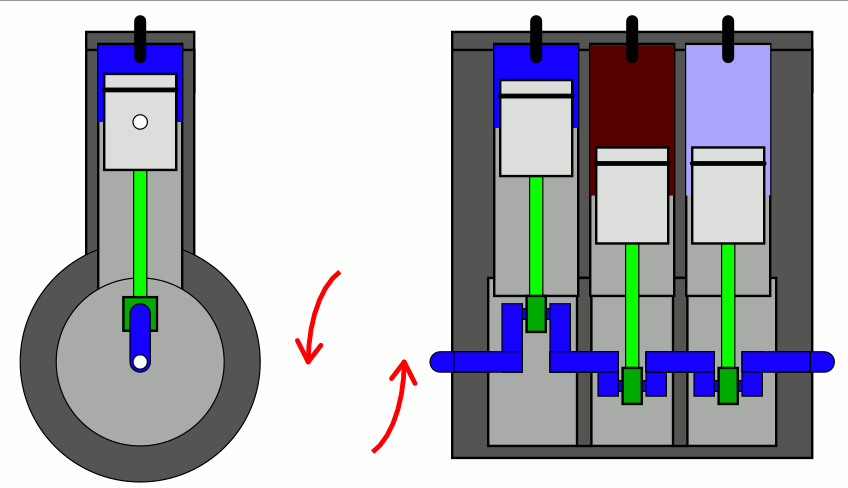
Straight-three engines generally employ a crank angle of 120°.[1] This gives perfect first and second order balance on reciprocating mass, but an end-to-end rocking motion is induced because there is no symmetry in the piston velocities about the middle piston. The use of a balance shaft reduces this undesirable effect.
An inline three-cylinder engine with 180° crankshaft can be found in early examples of the Laverda Jota motorcycle made by Italian manufacturer Laverda. In these engines, the outer pistons rise and fall together like a 360° straight-two engine. The inner cylinder is offset 180° from the outer cylinders. In these engines, cylinder number one fires, then 180° later cylinder number two fires, and then 180° later cylinder number three fires. There is no power stroke on the final 180° of rotation. This unusual crank angle came to be due to lack of proper tooling at the factory, which also made vertical twin engines that utilized a 180° crankshaft. After 1982, this engine had the regular 120° crank angle.
Triumph's 2020 Tiger 900 has been developed with a so-called "T-Plane" big-bang firing order engine. This design has crank throws at 90° intervals, such that the throws for cylinders 1 and 3 are separated by 180° - the three throws together forming a "T" shape when viewed from the end. Triumph claim this configuration improves engine character and sound,[2] as well as off-road feel and "rider connection to the rear wheel".[3] Firing intervals are 180-270-270 crank degrees.
2. Automobile Use
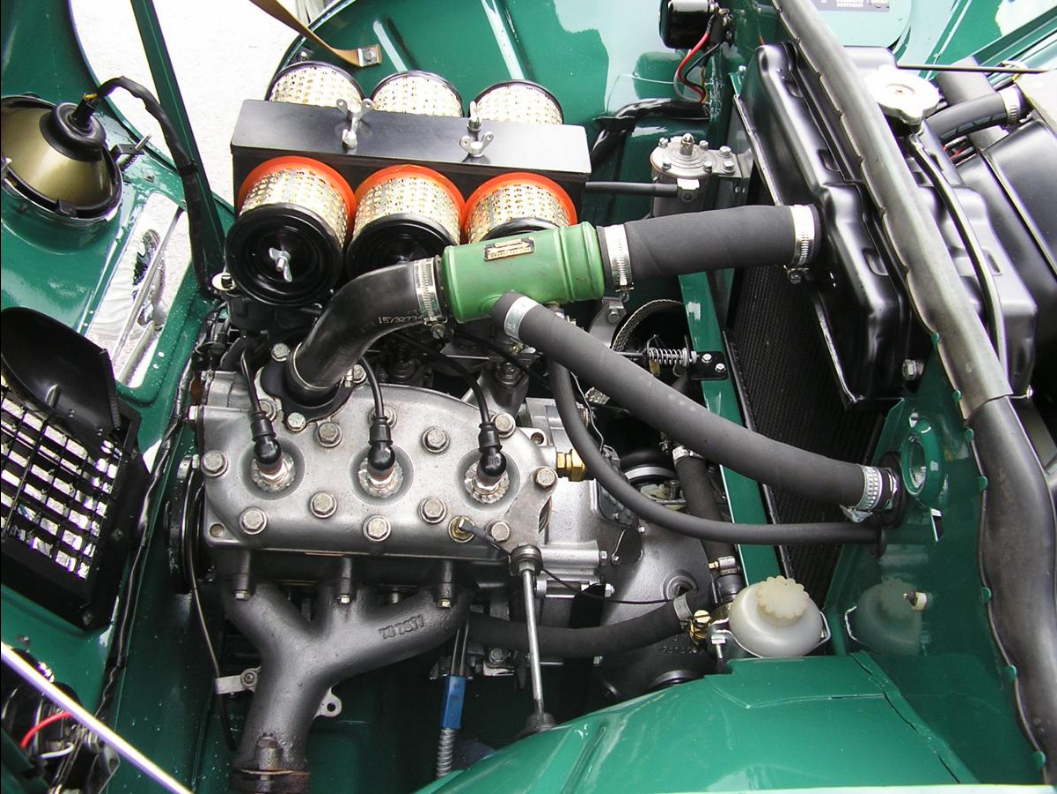
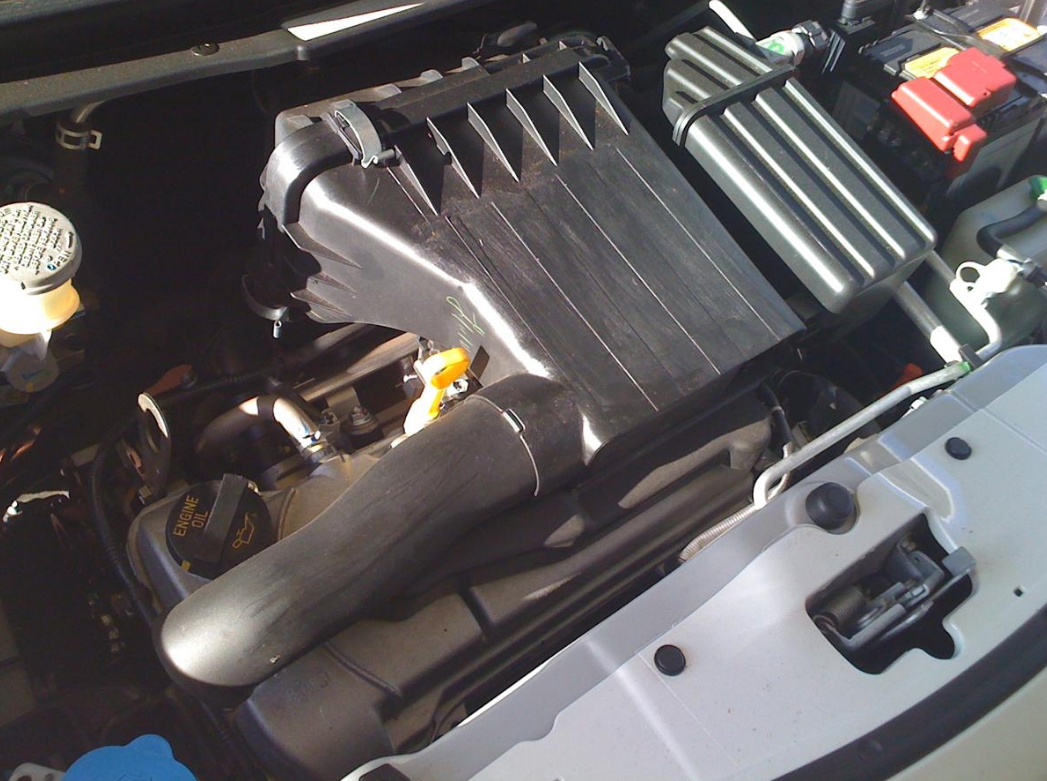
The smallest inline-three, four-stroke automobile engine was the 543 cubic centimetres (33.1 cu in) Suzuki F5A, which was first used in the 1979 Suzuki Alto/Fronte. The 1967 Suzuki Fronte featured a 256 cubic centimetres (15.6 cu in) two-stroke I3 engine. Smart currently produces a diminutive 799 cubic centimetres (48.8 cu in) inline-three diesel engine. Most inline-three engines fall below 1.2 litres. A 1,779 cubic centimetres (108.6 cu in) diesel engine was produced by VM Motori for the 1984 Alfa Romeo 33 1.8 TD, the largest inline-three produced for automotive use. Detroit Diesel Series 71 and Series 53 engines were available in 3 cylinder form for trucks and farm tractors.
Basic versions of the Suzuki Swift (and its related badge-engineered versions) used a 993 cc inline-three-cylinder engine,[4] with single-point injection.[5] The same engine was also used in the Suzuki Wagon R+, with multi-point injection.[6] This was replaced from 2003, with an Opel-sourced 998 cc unit, with four valves per cylinder and variable-length intake manifold, also used on the similar Opel Agila and the third generation of the Opel Corsa, and later on the Suzuki Splash and the fifth generation of the Opel Corsa. The Opel models previously used a 973 cc engine, which was initially featured on the second generation of the Opel Corsa.
Some Daihatsu cars use straight-three engines. The Charade [4] and the Mira/Cuore uses this engine type.[7] Three-cylinder 1.0-litre diesel and turbodiesel engines were also offered in Daihatsu Charades. Korean cars Daewoo Tico, based on the 1988 Suzuki Alto, and later base versions of Daewoo Matiz also used inline-three 796 cubic centimetres (48.6 cu in) 41 horsepower (31 kW; 42 PS) S-TEC petrol engine.
The Volkswagen Group is known for using three-cylinder petrol and diesel engines, in the Audi A2, Volkswagen Polo, Volkswagen Up!, Volkswagen Fox, Volkswagen Lupo, SEAT Ibiza, SEAT Córdoba, SEAT Mii, Škoda Citigo and Škoda Fabia. These engines range from 1.2-litre petrol,[8] with four valves per cylinder, that delivers 47 to 65 kilowatts (64 to 88 PS; 63 to 87 bhp), to 1.4 TDI diesel,[9] that delivers 51 to 66 kilowatts (69 to 90 PS; 68 to 89 bhp) and has turbocharger with variable vane geometry. The most innovative three-cylinder engine the Volkswagen Group released was the 1.2 TDI diesel (launched in 1998),[10] that was one of the first all-aluminium diesel engines and at the time of release was the lightest and most economic engine in production. It was used in the "3L" versions (from its diminutive fuel consumption of 3 litres per 100 kilometres or 94 miles per imperial gallon) of the Audi A2 and the Volkswagen Lupo. Another three-cylinder engine is the 1.2 TDI diesel launched with the fifth generation of Volkswagen Polo (in 2009), that uses common rail injection (unlike the previous 1.2 TDI engine, which used unit injectors).
Subaru used a straight-three engine in the Subaru Justy,[4] and the export version of the Subaru Sambar, called the Subaru Sumo, which had their Subaru EF engine.
Mitsubishi has made extensive use of three-cylinder engines, which have also been used in the Smart ForTwo, since 2004 on the Mitsubishi Colt,[11] and from 2012 on the Mitsubishi Mirage.[12] A three-cylinder diesel engine was also used on the Mitsubishi Colt and the Smart Forfour.
In the 1950s and 1960s, the Saab 93, Saab 95, Saab 96, and certain DKW automobiles were powered by inline-three-cylinder, two-stroke engines. Also, the Wartburg automobiles manufactured in Eastern Germany, and FSO Syrena manufactured in Poland, used this kind of engine.
The first generation Honda Insight (2000–2006) used a 1.0-litre inline-three engine in conjunction with an electric motor in its hybrid system.
The Toyota Peugeot Citroën Automobile (TPCA) joint venture is using a common 996 cc inline-three-cylinder engine in models of the Aygo, 107 and C1 respectively, which is derived from Daihatsu. The same engine has been provided for the Toyota Passo, the Toyota Yaris, the Toyota Agya, the Toyota Belta, the Toyota iQ, and for the Daihatsu Boon, the Daihatsu Cuore, the Daihatsu Ayla and the Daihatsu Boon-based Subaru Justy (see Toyota KR engine).
Nissan has developed a 1.2-litre three-cylinder version of their HR series of petrol engines, which is used since 2010 for the Nissan Micra, the Nissan Almera (Thailand) and the Nissan Note. There is also a supercharged version, with direct injection and variable valve timing.[13]
The Hyundai Motor Group used a 1.5-litre three-cylinder diesel engine (developed by VM Motori) on the second generation of the Hyundai Accent, the Hyundai Getz and the Hyundai Matrix, and developed its own 1.1-litre three-cylinder diesel engine (part of their U-Line), which has been used in the Kia Picanto and the Hyundai i10. Another 1.0-litre three-cylinder petrol engine (part of the Kappa series) has been used in the Hyundai i10 and the Hyundai HB20.
Exclusively for the Indian market, the Chevrolet Beat is offered with a 1.0-litre (936 cc) three-cylinder diesel engine, called XSDE (Xtra Smart Diesel Engine). It was co-developed by GM Powertrain Torino and the GM Technical Center India, and uses the Fiat MultiJet diesel technology.[14]
Ford started offering their new turbocharged 1.0-litre three-cylinder EcoBoost unit in the Focus from 2012, having never before built a regular production car engine with fewer than four cylinders.[15] This new engine features several innovations, including the use of an unbalanced flywheel to shift the inherent three-cylinder imbalance to the horizontal plane where it is more easily managed by engine mounts, and so remove the need to use balancer shafts.[16] In 2013, it was made available for the Fiesta. In 2015, this engine was named International Engine of the Year ‘Best Engine Under 1.0‑litre’ for the fourth consecutive year.[17] Ford claimed at the time that ten models in Europe could be equipped with the 1.0-litre EcoBoost engine, and that one in five all-new Ford vehicles sold in Europe in 2014 were equipped with the 1.0-litre unit, including almost two in five for Fiesta. In 2016, Ford offered a 1.0 litre turbocharged 3-cylinder EcoBoost engine with cylinder deactivation, claimed to be a world first for this feature in three-cylinder engines.[18] The 7th generation of the Fiesta ST (2018) uses a turbocharged 1.5 litre 3-cylinder EcoBoost engine, replacing a four-cylinder engine in this model.[19]
In September 2012, Renault introduced a new turbocharged 0.9-liter TCe engine, that is used in the fourth generation of the Renault Clio, the Renault Captur and in the second generation of the Dacia Sandero and Dacia Logan.
In October 2013, the PSA Peugeot Citroën group inaugurated the production line of their new turbocharged three-cylinder 1.2-litre petrol engine, in Douvrin, France. The engine, branded EB Turbo PureTech, will be first fitted on the Citroën C4 and the Peugeot 308, in the first half of 2014.[20]
Starting from 2014, the Opel Adam will be offered with a new turbocharged three-cylinder engine, mated to a six-speed manual gearbox.[21] This engine, branded SIDI (Spark Ignition Direct Injection), uses direct injection, continuously variable valve timing and has a lightweight aluminium cylinder block.[22]
The BMW B38 is a DOHC 1.5 litre 3 cylinder turbocharged petrol engine. The B38 is the first use of BMW's modular engine strategy for gasoline and diesel engines, all using the same bore spacing, and all producible on the same assembly line equipment. This engine was first used in the 2013 BMW i8 and 2014 Mini Hatch - replacing the previous four-cylinder engine in the Mini - and is currently used in the BMW F40 118i, BMW F22 218i, BMW X1 sDrive18i, BMW X2 sDrive18i. It was previously used in the BMW F20 118i and BMW F30 318i.
3. Motorcycle Use
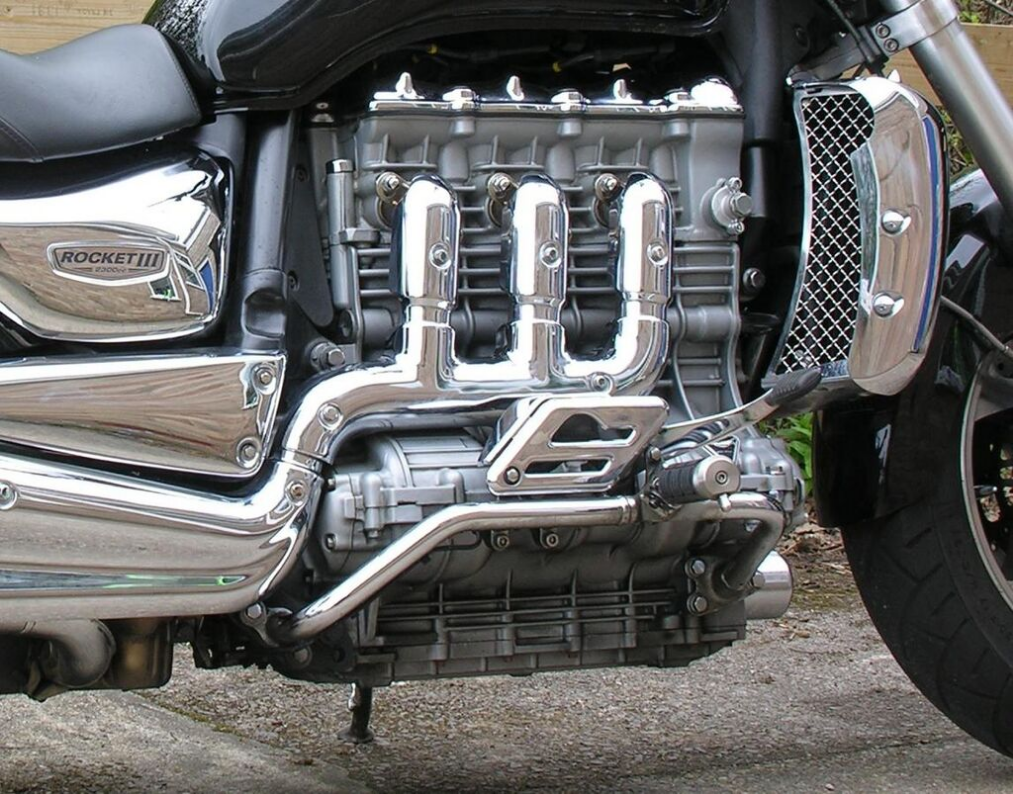
For motorcycles, the inline three-cylinder engine is considered advantageous as it is narrower than an inline-four and produces less vibration than a twin cylinder vehicle.[23]
3.1. Four-Stroke
Four-stroke straight-three motorcycle engines have been produced for both road and racing purposes[24] by Aprilia, Laverda,[24][25] Triumph, Yamaha, BMW, Benelli, Petronas, MV Agusta, and BSA.[24][26]
When BMW first moved to watercooled engines they first released the K100 I4 closely followed by the K75 with a 3 in line engine. the K75 was very popular due to the lower weight and the good torque range provided by the 3 cylinder engine.
The Triumph Rocket III, has a 2,294 cc (140.0 cu in) straight-three engine and the company has produced a number of other transversely mounted straight-three engines,[27] such as the water-cooled T509 Speed Triple, which was also the company's first fuel injected machine; and 1,050 cc Speed Triple.[28]
In 2019, the Moto2 class in the MotoGP World Championship switched to using Triumph 765 cc (46.7 cu in) triple engines.[29]
Current production motorcycles with triple engines:
- MV Agusta F3 675, F3 800, Brutale 675, Brutale 800, Rivale 800, Stradale 800
- Triumph Daytona 675, Street Triple, Speed Triple, Rocket III, Tiger (800, Sport 1050, Explorer 1200), Trophy, Sprint
- Yamaha MT-09/FZ-09, Yamaha XSR900, Yamaha Tracer 900
- Benelli: TNT899, TNT 1130 R, TNT 1130 K, TNT 1130 K Amazonas
3.2. Two-Stroke
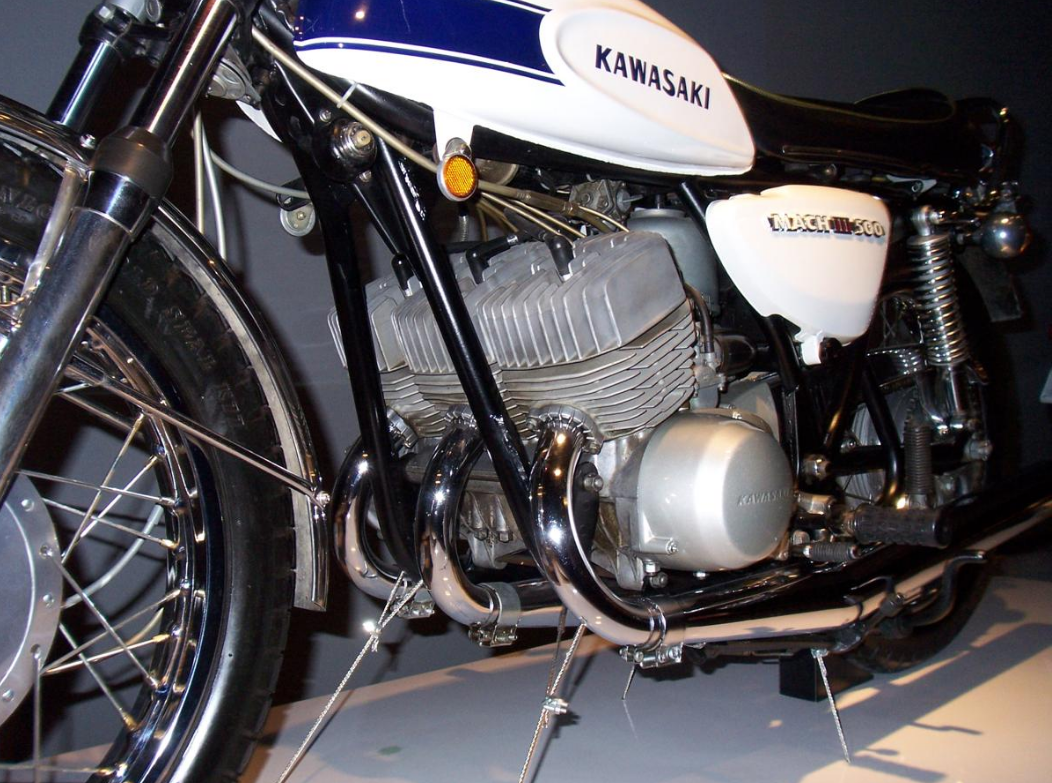
Following a comparative study at Osaka University's Faculty of Engineering, between in-line and L-shaped motors, Kawasaki Motors decided to develop a range of high performance, two stroke straight-three engines.[30] Between 1969 and 1978, the company produced air-cooled inline, triple engines with capacities of 250 cc, 350 cc, 400 cc, 500 cc, and 750 cc,[31] and the H1-R 500cc and H2-R or KR750 750 cc racing models in both air-cooled and water-cooled forms.[32]
Between 1972 and 1977, Suzuki made three two-stroke straight-three production runs; the air-cooled GT380 and GT550, and the water-cooled GT750 and TR750 racer based on it.[32]
4. Non-Automotive Use
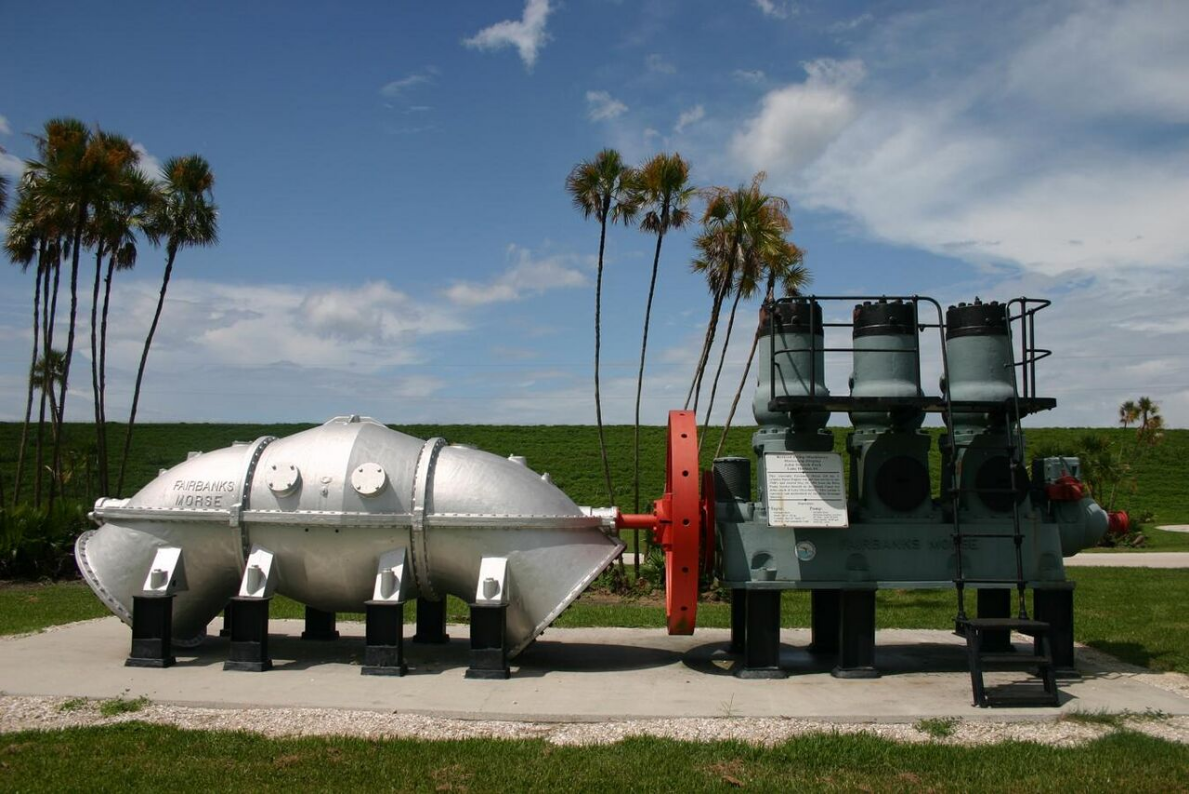
Inline three-cylinder engines are not limited to propelling motor vehicles. They may also be used in general industrial applications. An example is the Fairbanks-Morse 32E14 slow-speed diesel engine which is shown coupled to a water pump.
4.1. Agricultural Use
Inline three engines are common in diesel engined tractors, as well as other agricultural machinery. Nearly all manufacturers of diesel tractors have had models with three-cylinder engines. Perhaps the best known example of any kind of three-cylinder diesel engine is the Perkins AD3.152 that was used in Massey Ferguson 35 tractors, as well as in Fordson Dexta and several other tractors. This engine was also used for marine and stationary applications. Other manufacturers include Nuffield(BMC), Bolinder-Munktell/Volvo BM, International Harvester, John Deere, Deutz-Fahr, Kubota, Ford and many others.
4.2. Aviation Use
The Hewland AE75 is a 750 cc lightweight two-stroke inverted three-cylinder liquid-cooled aircraft engine that produced 75 bhp (56 kW), manufactured in the mid-1980s by Hewland.[33]
The content is sourced from: https://handwiki.org/wiki/Engineering:Straight-three_engine
References
- "Here's The Problem With Three-Cylinder Engines" (in en). https://www.carthrottle.com/post/heres-the-problem-with-three-cylinder-engines/.
- "TIGER 900 ENGINE & CAPABILITY". https://www.triumphmotorcycles.co.uk/motorcycles/adventure/tiger-900/engine-and-capability. Retrieved 10 February 2020.
- Cameron, Kevin. "Triumph’s New T-Plane Firing Order Explained". https://www.cycleworld.com/story/bikes/triumphs-new-t-plane-firing-order-explained/. Retrieved 10 February 2020.
- Dinkel, John, ed (July 1988). "Comparison Road Test: 3x3". Road & Track (Newport Beach, CA USA: Diamandis Communications) 39 (11): 66–74. ISSN 0035-7189. "Its engine is still the same 993-cc sohc inline-3, producing 48 bhp at 5100 5100 rpm and 57 lb-ft torque at 3200...". http://www.worldcat.org/issn/0035-7189
- Daniel Zevedei. "Suzuki Swift 1.0 GL - 5-doors, hatchback". Auto-types.com. http://www.auto-types.com/suzuki-swift-10-gl-5-doors-hatchback-5-speed-manual-63979.html. Retrieved 2014-06-20.
- Daniel Zevedei. "Suzuki Wagon R+ 1.0 GA - 5-doors, mpv". Auto-types.com. http://www.auto-types.com/suzuki-wagon-r--10-ga-5-doors-mpv-5-speed-manual-64089.html. Retrieved 2014-06-20.
- Logan (September 23, 2011). "New car: 2012 Daihatsu Mira e:S". Motor Mania. http://motormania.eu.com/MM/2011/09/23/car-2012-daihatsu-mira-es/. Retrieved 2012-07-03. "Motivation comes from a 3-cylinder, 650cc petrol engine that kicks out a mere 51bhp (52PS/38kW) and 60Nm (44lb-ft) of torque."
- "New VW Fox in depth". Volkswagen AG. WorldCarFans.com. 2005-04-04. http://www.worldcarfans.com/10504049256/6. Retrieved 2009-08-18.
- "New Audi A2 1.4 TDI with 90 bhp engine". AUDI AG. WorldCarFans.com. 2003-11-10. Archived from the original on 2013-01-05. https://archive.is/20130105113135/http://www.worldcarfans.com/103111011117/new-audi-a2-14-tdi-with-90-bhp-engine. Retrieved 2009-08-22.
- "Audi A2 1.2 TDI: the three-litre car from Audi". AUDI AG - press release. AudiWorld.com. 1999-11-28. http://www.audiworld.com/news/99/a2_2/content.shtml. Retrieved 2009-08-22.
- Daniel Zevedei. "Mitsubishi Colt 1.1 Inform - 5-doors, hatchback". Auto-types.com. http://www.auto-types.com/mitsubishi-colt-11-inform-5-doors-hatchback-5-speed-manual-40988.html. Retrieved 2014-06-20.
- Jackson, Paul (February 1, 2008). "Chapter 6: The Next Generation". The Little Book of Smart. Veloce Publishing. pp. 94–95. ISBN 978-1-84584-148-5. "There were plenty of changes under the skin, too, with the original smart-built turbocharged engine being replaced (on petrol-engined versions) by a Mitsubishi design – still with three cylinders but now a larger (999cc) capacity."
- "HR12DDR Engine | NISSAN | TECHNOLOGICAL DEVELOPMENT ACTIVITIES". Nissan-global.com. http://www.nissan-global.com/EN/TECHNOLOGY/OVERVIEW/hr12ddr.html. Retrieved 2014-06-20.
- LAUNCHED! Chevrolet Beat diesel starts at Rs 4.29 lakh. BS Motoring. July 25, 2011. http://www.bsmotoring.com/news/launched-chevrolet-beat-diesel-starts-at-rs-429-lakh/3813/1.
- "Smallest Ford Engine Ever! Three-Cylinder EcoBoost (and Two New Transmissions)". https://social.ford.com/en_US/story/sustainability/green/smallest-ford-engine-ever-three-cylinder-ecoboost-and-two-new-transmissions.html. Retrieved 2017-04-03.
- "Ford's 3-cyl. EcoBoost Delivers the Goods". 2014-05-15. http://wardsauto.com/technology/ford-s-3-cyl-ecoboost-delivers-goods. Retrieved 2017-04-03.
- "Ford 1.0-litre EcoBoost Wins 8th Engine 'Oscar' In 4 Years, 3-Cylinder Tops Its Class In International Engine Of The Year". 2015-06-17. https://media.ford.com/content/fordmedia/feu/en/news/2015/06/17/ford-1-0-litre-ecoboost-wins-8th-engine-oscar-in-4-years--3-cyli.html. Retrieved 2017-04-03.
- "Ford To Offer Fuel-Saving Cylinder Deactivation Tech FOR 1.0 Litre EcoBoost; Global First For A 3-Cylinder Engine". 2016-11-29. https://media.ford.com/content/fordmedia/feu/en/news/2016/11/29/ford-to-offer-fuel-saving-cylinder-deactivation-tech-for-1-0-lit.html. Retrieved 2017-04-03.
- "Next-Gen Ford Fiesta ST Debuts 200 PS, 3 Cylinder, 1.5-Litre EcoBoost Engine And Drive Modes For Ultimate Fun-To-Drive". 2017-02-24. https://media.ford.com/content/fordmedia/feu/en/news/2017/02/24/next-gen-ford-fiesta-st-debuts-200-ps--3-cylinder--1-5-litre-eco.html. Retrieved 2017-04-03.
- http://www.psa-peugeot-citroen.com/en/inside-our-industrial-environment/innovation-and-rd/eb-turbo-puretech-engine-the-new-generation-petrol-turbo-engine-article
- "New All-Aluminum 3-Cylinder Turbo Sets Refinement Benchmark". Media.opel.com. 2013-08-07. http://media.opel.com/content/media/intl/en/opel/news.detail.html/content/Pages/news/intl/en/2013/opel/08-07-newall-aluminium-3-zylinder-turbo.html. Retrieved 2014-06-20.
- "Opel presents new 1.0 ECOTEC Direct Injection Turbo engine at Aachen Colloquium". Media.gm.com. 2013-10-08. http://media.gm.com/media/intl/en/opel/news.detail.html/content/Pages/news/intl/en/2013/opel/10-08-opel-sidi-turbo-aachen.html. Retrieved 2014-06-20.
- How Your Motorcycle Works: Your Guide to the Components & Systems of Modern Motorcycles. Peter Henshaw Veloce Publishing Ltd, 15 Sep 2012
- 365 Motorcycles You Must Ride. Dain Gingerelli, Charles Everitt, James Manning Michels. MBI Publishing Company, 10 Jan 2011
- The Motorcycle Book, Alan Seeley. MotorBooks International, 2 May 2004
- Human Hurricane, Wilson, Steve. Walneck's Classic Cycle Trader, April 2005
- Triumph Motorcycles: Twins & Triples. Timothy Remus. MotorBooks International, 10 Oct 1997
- Cycle world, Volume 44 CBS Publications, 2005. "inline triple"
- Triumph enters Grand Prix racing as Moto2 engine supplier The Telegraph, 18 December 2018. Retrieved 15 December 2019. https://www.telegraph.co.uk/cars/features/triumph-enters-grand-prix-racing-moto2-engine-supplier/
- The Kawasaki Triples Bible: All Road Models 1968-1980, Plus H1r and H2r Racers in Profile. Alastair Walker, Veloce Publishing Ltd, 15 Jan 2011. P.18
- 365 Motorcycles You Must Ride. Dain Gingerelli, Charles Everitt, James Manning Michels. MBI Publishing Company, 10 Jan 2011. P.188
- Japanese Production Racing Motorcycles. Mick Walker. Redline Books, Sep 2004
- “Pilot” magazine February 1986 page 32
